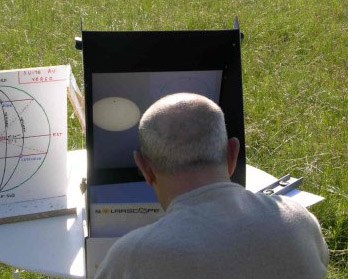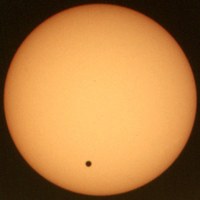Observing Venus and taking photos of the transit
Observing
To the naked eye
We must never look at the sun to the unprotected naked eye; we might seriously damage our eyes. Even when the Sun rises, it is usually dazzling.
Screens for the observation of the sun exist such as the special eclipse glasses or the welder’s glasses n°14. Venus will appear as a tiny black dot on the sun’s disc.
 | Observation through a welder’s glass fixed on a cardboard |
If you start observing at the sunrise, the sunscreens might be too strong as the Sun’s light is dimmed by the atmosphere. So the simplest way is to observe by projecting.
By projecting with a pair of binoculars or a telescope.
It is the safest way provided that we stay close to the instrument to watch that no one looks at the ocular, which would be extremely dangerous. This method can be used with a pair of binoculars or a telescope by setting at the back a projection screen.
The solarscope enables us to observe safely the Sun, it is based on the same principle.
 | Observation of the transit of Venus on June 8, 2004 with a Solarscope. We can guess the black spot of Venus in the photo, at the top of the Sun’s disc of light. |
With a telescope equipped with a sunscreen
We mustn’t use the small sunscreens to screw on the ocular: as the Sun’s light enters the instrument, the screen could warm itself and crack. We must have a sunscreen made for the observation of the Sun which is to be fixed at the entry of the instrument. This is what gives the best observation but we need to have the required equipment.
 | Observation behind a telescope equipped with a sunscreen made of a glass plate covered by a thin metal layer. |
Taking photos.
If you hope to take a picture of the black spot of Venus, you need either to have a zoom lens or use an astronomic instrument. At the sunrise, if the Sun is sufficiently darkened by the atmosphere, we could try photos without screens like in this photo of partial solar eclipse. In order to centre, we must look at the screen of the camera (and not at the viewfinder if there is one) to avoid damaging our eyes.
 | The eclipse of May 31, 2003 photographed at the sunrise without sunscreens |
If the light of the Sun is too strong, we will have to use a screen. Sunscreens in mylar and glass sunscreens can be found in astronomy shops for the observation. It would be ideal to have sunscreens of different densities. If the sunscreen is not sufficient, we might only damage the camera..
 |  |  |
| 1. Telephoto lens | 2. Lunette avec appareil compact derrière oculaire. | 3. Lunette sans oculaire avec boîtier reflex sans objectif. |
| Fig. 6. Three methods of photo for the transit on June, 6th. | ||
We will have to add a sunscreen at the entry of the instrument except perhaps as the sunrise if the Sun is not dazzling.
 | Vénus photographiée devant le Soleil lors de son dernier passage, le 8 juin 2004 avec un télescope de 200 mm de diamètre muni d’un filtre en verre. |
Document Actions


